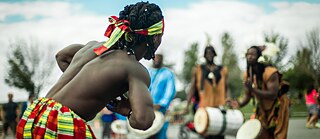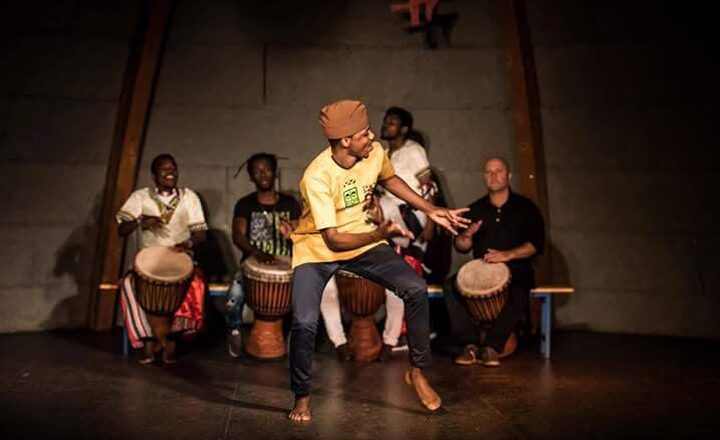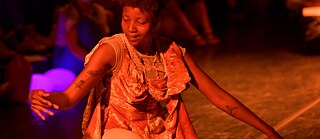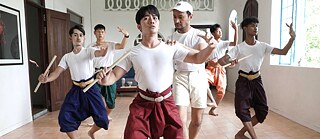Decolonising Dance What Is “African” Dance?

Do Europeans really understand the complexities or ethnic compositions of the African continent? Dance anthropologist Adebayo Adeniyi questions the Eurocentric account of dance history and contradicts the term referring to “African dance“ as a phenomenon.
Dance history and historiography, over the years, has been filled with many generalisations and complexities which even begins with the question of what is considered as dance in each culture. In most scholarly accounts (mostly Eurocentric) the history of dance has been: a place, a style, a form and period specific. Descriptions like “Dance History”, or most controversially, Curt Sachs book titled World History of the Dance, give a sense of a global historical account of dance across the entire world. Although, these generalised accounts are mostly about the 15th to 18th century court and theatre dances followed by modern dance era in Europe and the USA which characterise these global categorisation to whet the appetite of western scholars for the western consumer. The term “global” itself, which has been conferred on certain dance styles is derived and packaged from the influence of European colonising power not necessarily by artistic eclecticism, evolutionism or diffusionism ideology.“The packaging of dance history into neat periods or shapes with a beginning, middle and end not only enables the organisation of a curriculum (‘next week we will do Romantic period’) but also gives meaning to those periods, making them discrete and self-contained in the specificity of their characters. The dangers inherent in this packaging are that those activities whose periods of time do not fall neatly under the prescribed labels don’t fall anywhere at all. They are less researched under-recorded, not studied”. (Carter 2017, p. 115)
The “packaging” here becomes even more problematic when contemporary is mixed up with the contemporaneous. If we were to consider Bàtá dance from Nigeria and ballet to exist since around the same period in time, why is it that ballet receives all the prominence and is considered mother of all dances? Some even argue that ballet training builds a “universally ideal body”. Ideal for what specific purpose?
 Bata Dance to Djembe drums in Budapest
| © József Gorácz
Why would a Bàtá dancer need ballet training? Bàtá dances from the Yòrùbá culture come with its own education, vocabulary and bodily knowledge. In which part of this neatly “packaged“ historical account does Bàtá dance fall into? Bàtá does not fall anywhere because it is an ethnic dance from an African country.
Bata Dance to Djembe drums in Budapest
| © József Gorácz
Why would a Bàtá dancer need ballet training? Bàtá dances from the Yòrùbá culture come with its own education, vocabulary and bodily knowledge. In which part of this neatly “packaged“ historical account does Bàtá dance fall into? Bàtá does not fall anywhere because it is an ethnic dance from an African country.Many African societies relied on oral transmission as the means of knowledge transmission. The Western idea of writing proposes and imposes a kind of tangible evidence of knowledge storage and transmission considered to be superior while believing that oral transmission is ephemeral and changeable.
“Show Me African Dance!”
Scholars like Purkayastha have argued about India being one of the Orients most popular products, created, marketed and consumed by a western imagination. She goes on to argue that, Indian dances were either accepted or rejected by that imagination depending on how successfully they whetted the western appetite for an exotic Orient. The African continent, its history and heritage, including its dances seem to follow the same fate just like the Orient, as they are both products of western colonisation. Many times I, as a Nigerian, have heard “show me African dance” from my international colleagues, in most cases, with love, curiosity and enthusiasm. African countries are like India, a product of western imagination and are also used to whet the western appetite for the exotic.Africa is a continent with several countries, several ethnic groups, cultures, as well as dances. The fact that Nigeria was divided into the three major ethnic groups; Hausa, Igbo Yoruba, for the convenience of the British colony does not necessarily mean that it is a country of three ethnic groups. There are over 200 ethnic groups The British colonisers only tried to make another United Kingdom out of Nigeria. So, as a Nigerian I cannot even teach all the dances from all Yoruba speaking regions nor dances of over 200 ethnic groups and a population of over 180 million people not mention teaching “African dance” as it is referred to as “one thing”. European scholars and audiences need to be conscious of this generalisation crisis, similar to not being able to show “European Dance”, the same applies to the African continent. It would be more appropriate to see dances or movement practices (especially ones from the African continent) as born out of their respective cultures, evolution or diffusion over the years instead of making the western model the template for all. The phenomenon or term “African Dance” does not exist. It is only a figment of the colonial imagination.
Quoted sources:
Carter, Alexandra: Destabilising the Discipline: Critical debate about history and their impact on the study of dance. Rethinking Dance History, Issues and Methodologies. Nicholas, L. & Morris G. (eds.) 2 ed. London, Routledge, 2017, pp. 115-122.


